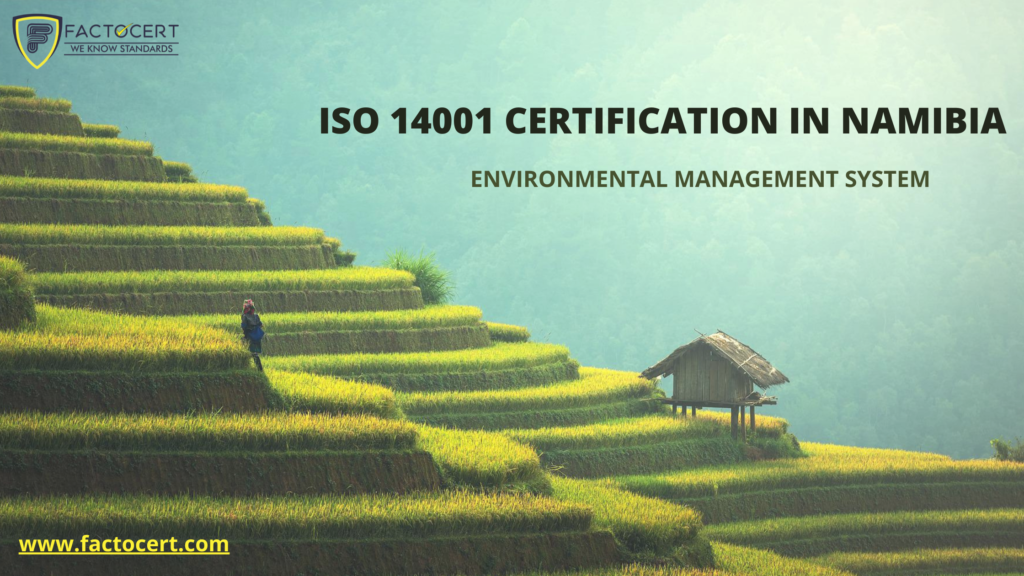What documentation is required for ISO 14001 Certification in Namibia?
ISO 14001 Certification in Namibia requires you to keep written proof that your Environmental Management System (EMS) complies with the standard. Although the standard specifies the kind of documentation that must be provided, it does not specify how you must operate or record your evidence. Your documentation’s purpose is to guarantee that effective environmental practices are in place. Some of these papers also indicate that your whole organization is aware of and working toward your ecological objectives, which will assist you in meeting both concrete and achievable environmental goals.
The Purpose of the ISO 14001 Certification in Namibia (Environmental Management System)
The scope defines the kind of operations your ISO 14001 Certification in Namibia (EMS) will do and its limitations. Setting the limits will need to outline which elements of your organization will be subject to the EMS(ISO 14001 Certification in Namibia). This includes procedures, places, departments, divisions, and so on.
Outlining the scope of the management system will include explaining the sorts of goods and services offered by your organization, as well as where they are offered In most situations, ISO 14001 Certification in Namibia (EMS) will apply to your whole organization; nevertheless, there may be times when it is either unsuitable or impossible for a process, location, or team to come within the scope of your management system; in these cases, a narrower, more specialized area will be necessary.
Environmental Risks and Opportunities Assessment
This will define and recognize the environmental hazards and opportunities that may arise due to the organization’s operations. Risks in unusual and emergency scenarios will be included. This will also contain the opportunity to embrace change and enhance the environment. The standard does not specify a specific technique or risk process that must be documented, but you must show that a risk-based strategy is used.
You should be able to describe your technique and approach and provide documentation such as a business plan, strategy, or operational plan. This written proof might be connected to the standard’s numerous clauses, which would give the analyses required to achieve this criterion.
Environmental Aspects Evaluation
The actions that influence the environment are referred to as environmental elements. For example, every company requires resources, utilizes energy, and creates trash to operate, and as a consequence, ecological repercussions will arise.
The following are some examples of environmental aspects:
- Utilities such as water, electricity, and gas are used.
- Waste generation.
- Emissions of air, smoke, and fumes.
- Effluent disposal.
- Bulk oil storage tanks, for example, can pollute the environment.
After discovering these environmental characteristics, you’ll need to assess the potential impact on the environment and then use a “risk” score system to select the most critical ones. The standard does not mandate the scoring system; as long as it is suitable for the purpose, it may be as simple or sophisticated as you like. For example, there are many approaches you may use to determine the possibility of an event (failure) occurring and the possible effect if it does. As a result, a high-risk impact event that is likely to happen would obtain a high score, suggesting that it is a business issue, while a low-risk impact event that is unlikely to occur would receive a low score.
Information on Performance Monitoring
One of the advantages of ISO 14001 Certification in Namibia is its focus on continuous improvement, so monitoring the performance and efficacy is critical. Therefore, you must record these assessments and prove that your organization evaluated what to measure, how, and when and that the results of any choices provide sufficient process control.
Procedures for Operational Control
ISO 14001 Certification in Namibia requires organizations to establish and implement their operational controls in a manner relevant to the industry in which they operate. As a result, the standard does not specify those controls or how they should be implemented, but you must maintain recorded proof that your operational controls guarantee that:
All legal and regulatory criteria have been satisfied. Environmental goals have been analyzed and specified internal, external, and outsourced procedures.
Any training needs have been evaluated, executed, and reviewed. If your company has a bulk oil storage tank, your auditor may demand to see operational controls for filling and decanting the tank. Procedures and training for spill cleanup would be required as well. Likewise, if your company has an effluent treatment facility, it should have the necessary operating instructions and training. To start, you should review your organization’s environmental aspects and write down all of the organization’s environmental controls. If there are no described controls, creating them could be a good moment.
For More information regarding ISO 14001 Certification in Namibia click here to visit us or mail us at contact@factocert.com





